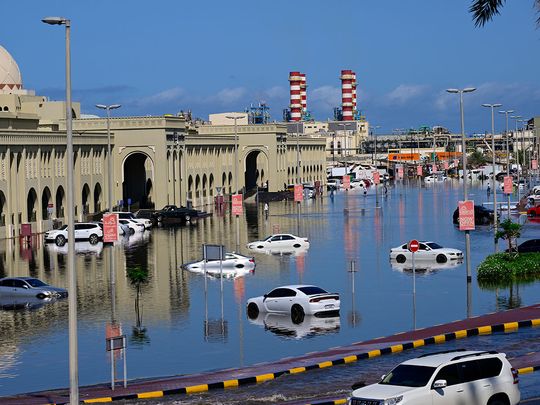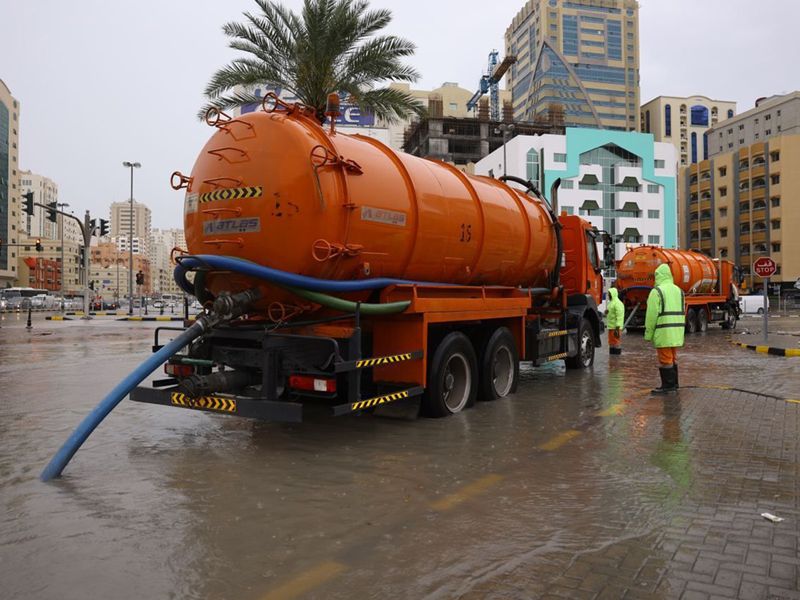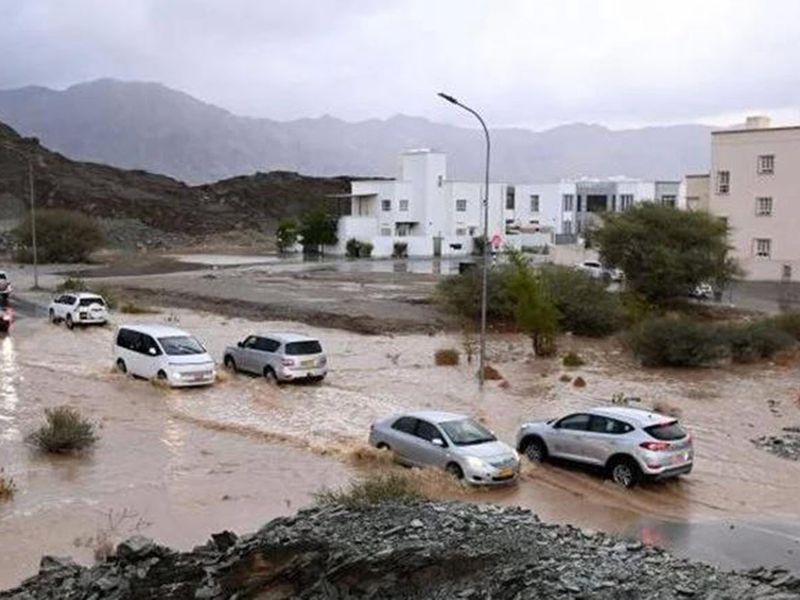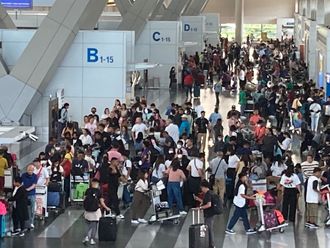
Dubai: The unprecedented rainfall in the UAE on Tuesday (April 16) resulted in flooding that disrupted road traffic, grounded flights and halted the Dubai Metro and the Dubai Tram. Early warnings from the National Center of Meteorology helped cushion the impact, leading to distance learning for schools and work from home for the public sector and many private companies.
In the heaviest rain in 75 years, many people in cars were stuck on waterlogged streets. But the public sprang into action to help each other, extricating those trapped in cars and providing shelter to strangers.
The low-pressure weather system also brought torrential rains to Saudi Arabia, Bahrain and Oman, where 20 people died in the flooding.
Here’s what we know about the rains, flooding and the return to normality.
What caused heavy rains in the UAE?
A low-pressure weather system, which drew in warm, moist air and blocked other weather systems, was the leading cause, BBC said, adding that warmer air holds more moisture, increasing rain intensity.
While a deep low pressure moved from the southwest and Oman into the UAE, another low-pressure situation developed in the upper layer of the atmosphere over the UAE. Besides that, humid air moved from the Arabian Sea to the UAE and Oman since Sunday, causing unstable weather, according to Dr Habib Ahmed, a senior meteorologist at the National Center of Meteorology (NCM).
“The intensity of the rain was record-breaking, but this is consistent with a warming climate, with more moisture available to fuel storms and make heavy rainfall events and associated flooding progressively more potent,” BBC quoted Richard Allan, professor in climate science at the University of Reading, as saying.
Did cloud seeding contribute to the rain?
No. It wasn’t necessary since the low-pressure weather system carried plenty of moisture, and any cloud seeding would have had little impact.
Cloud seeding (spraying existing clouds with salts like silver iodide to condense water vapour) is employed only when conditions are insufficient for rain. In this case, the conditions for rain were good, and it posed a high flooding risk across the Gulf.
UAE meteorologist Dr Ahmed confirmed there was no cloud seeding.
“When such intense and large scale systems are forecasted, cloud seeding — which is a costly process — is not performed because [there is] no need to seed such strong systems of regional scale,” Prof Diana Francis, head of the Environmental and Geophysical Sciences at Khalifa University in Abu Dhabi, told the BBC.
How heavy was the rain on Tuesday, April 16?
It was the heaviest rainfall in the UAE since data collection started in 1949, WAM news agency reported. Khatm Al Shakla in Al Ain received about 256mm (10 inches) of rain in 24 hours until 9pm on Tuesday, April 16, 2024, UAE’s National Centre of Meteorology said.
What’s the weather forecast for the next few days?
The weather is expected to be stable in the coming few days with some cloudy days in and around Al Ain, Meteorologist Dr Ahmed said, adding that temperatures will rise gradually soon.
How did the UAE cope with the unprecedented weather?
The National Center for Meteorology warned UAE residents on Sunday about the weather system, saying there would be high winds and heavy rainfall on Tuesday and Wednesday. So schools opted for distance learning, while private and some public sector institutions adopted work-from-home routines. This helped drastically reduce the traffic on the roads.
It turned out to be a good move as several arterial roads and streets in many neighbourhoods across the UAE were inundated and had to be closed. That kept the public buses and taxis off the roads on many routes.
While Dubai Metro and Dubai Tram services were disrupted, airport operations were the worst affected. Flights from the Dubai International Airport (DXB) were severely hampered, and 21 flights were diverted to the Zayed International Airport in Abu Dhabi, where the operations continued unhindered. The functioning of the Sharjah airport too was impacted.
The early warnings helped, and people from all walks of life joined hands to help those stranded. In Sharjah, rain-affected families were provided shelter in hotels, Dr Ahmed Rashid Al Naqbi, Director of the Sharjah Government Communication Department, said.
How badly were the flights affected?
An unprecedented 1,244 flights were cancelled over two days at Dubai International (DXB) until Thursday (April 18) 10am, a Dubai Airport spokesperson told Gulf News, adding that 61 flights were diverted to nearby airports. The airport resumed partial operations Thursday morning out of Terminal 1 and Terminal 3, and full capacity is expected to be reached by Friday.
Operations at the Zayed International Airport in Abu Dhabi remained unaffected, although there were minor delays, according to the spokesperson. The airport also helped out DXB by receiving 21 flights diverted in 24 hours of inclement weather.
There was a disruption of flights in Sharjah too. Airport operations are slowly returning to normal now.
What was the impact of the heavy downpour on road traffic?
Road traffic was the most affected since many areas were waterlogged. Several major roads across the country had to be closed, and traffic had to be diverted in many places.
After a day of sunshine on Wednesday, most roads in Dubai have been reopened to traffic. Only a handful of roads are partially closed, and the Ittehad Road is yet to open.
Al Wahada Street, Al Khan Street, Jamal Abdul Nasser Street, Kind Abdul Aziz Street and Al Qasimia Street in Sharjah remain closed as efforts are underway to drain water from the roads.

Has the Dubai Metro services resumed?
Regular service has returned to the Red Line routes from Centrepoint to Dubai Internet City and from Jebel Ali to Expo 2020, according to the RTA’s X handle. Services on the Green Line from etisalat by e & to Abu Hail and Creek to Al Ras have resumed. Efforts are underway to restore services to the remaining stations, the RTA tweet added.
Has the Dubai Tram services returned to normal?
Yes. The Dubai Tram has resumed normal service and is operating as per the regular schedule. All stations are working smoothly, the RTA said.
Which other countries were affected by the weather system?
Bahrain, Oman and Saudi Arabia were lashed by heavy rains, resulting in flooding, as the low-pressure weather system wreaked havoc. After dumping record rainfall in the UAE, the weather system moved towards Iran, Pakistan and Afghanistan, according to a BBC report.

How was the flooding in Oman?
Heavy rains led to flooding that ravaged many areas in Oman, resulting in the deaths of 20 people. Musandam, Al Dhahirah, Al Buraimi, North Al Batinah and A’Dakhiliyah governorates, South Al Batinah, Muscat and parts of Al Wusta were affected.
What was the effect of the weather system on Saudi Arabia?
Torrential rains, strong winds, and hail lashed the Eastern Province. A vital tunnel on King Fahd Road in the eastern city of Dammam was closed as a precautionary measure. Schools in some governorates in the Riyadh region, including Wadi Al Dawasir, Afif, Dawadmi, Al Aflaj, Al Zulfi, Shaqra, Al Ghat and Al Majma’ah, were closed.
How did Bahrain cope with the heavy rain?
Bahrain was drenched by torrential rains from the low-pressure weather system in the region. Roads were flooded, throwing everyday life out of gear. Schools were closed, and people were asked not to venture out, the Daily Tribune from Manama reported.
Compensation will be given to the flood-affected, and the country is planning infrastructure upgrades.









